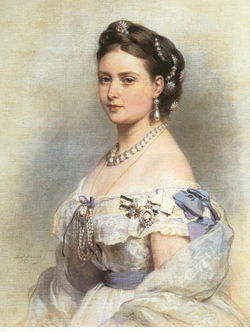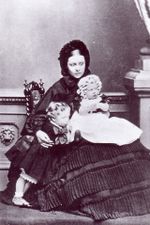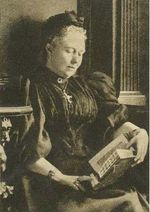Victoria, Princess Royal
Princess Victoria Adelaide Mary Louise (21 November 1840 – 5 August 1901) was the eldest daughter of Queen Victoria and her consort Albert. She was created Princess Royal of the United Kingdom in 1841. She became Empress consort in Germany and Queen of Prussia by marriage to Emperor Friedrich. After the death of her husband she became widely known as Empress Frederick (or, in German: "Kaiserin Friedrich").
Early life
Princess Victoria was born on 21 November 1840 at Buckingham Palace, London. Her mother was the reigning British monarch, Queen Victoria, the only daughter of King George III's fourth eldest son, Prince Edward Augustus, Duke of Kent. Her father was Prince Albert of Saxe-Coburg and Gotha. She was baptised in the Throne Room of Buckingham Palace on 10 February 1841 by William Howley, Archbishop of Canterbury and her godparents were the Dowager Queen Adelaide, the King of the Belgians, the Duke of Saxe-Coburg and Gotha, the Duke of Sussex, the Duchess of Gloucester and the Duchess of Kent.
As a daughter of the sovereign, Victoria was automatically a British princess with the style Her Royal Highness, styled HRH The Princess Victoria (and in addition being heiress presumptive to the throne of the United Kingdom before the birth of her younger brother Prince Albert, later Edward VII on 9 November 1841). In 1841, the Queen created Victoria Princess Royal, giving her an honorary title sometimes conferred on the eldest daughter of the sovereign. Victoria was then styled HRH The Princess Royal. To her family she was known simply as Vicky.
The education of Victoria was closely supervised by her parents. She was precocious and intelligent, unlike her brother Albert Edward. She was taught to read and write before the age of five by her governess Lady Lyttelton and to speak French by her French nursery maid. The Princess Royal learned French and German from various governesses and science, literature, Latin, and history by Sara Ann Hildyard. Prince Albert tutored her in politics and philosophy.
Marriage
In 1851, Victoria met her future husband, Prince Friedrich Wilhelm of Prussia (18 October 1831-15 June 1888), when he and his parents were invited to London by Queen Victoria and Prince Albert to attend the opening of the Great Exhibition. At the time, Friedrich, the son of Prince Wilhelm of Prussia and Princess Augusta of Saxe-Weimar, was second in line to the Prussian throne. The couple was engaged in 1855 while Friedrich was on a visit to Balmoral.
The Prussian Court and Buckingham Palace publicly announced the engagement on 19 May 1857. The couple was married, at Queen Victoria's insistence, at the Chapel Royal, St. James's Palace, on 25 January 1858. The marriage was both a love match and a dynastic alliance. The Queen and Prince Albert hoped that Victoria's marriage to the future king of Prussia would cement close ties between London and Berlin, and possibly lead to the emergence of a unified and liberal Germany.
Victoria and Friedrich had eight children:
| Name | Birth | Death | Notes. | |
|---|---|---|---|---|
| Prince Wilhelm, later Wilhelm II, German Emperor and King of Prussia | 27 January 1859 | 4 June 1941 | married 1st Princess Auguste Viktoria of Schleswig-Holstein (22 October 1858-11 April 1921) and had issue; 2nd Princess Hermine Reuss zu Greiz (17 December 1887-7 August 1947 |
|
| Princess Charlotte | 24 July 1860 | 1 October 1919 | married Bernhard III, Duke of Saxe-Meiningen (1 April 1851- 16 January 1928). | |
| Prince Heinrich | 14 August 1862 | 20 April 1929 | married Princess Irene of Hesse and by Rhine (11 July 1866-11 November 1953); and had issue. | |
| Prince Sigismund | 15 September 1864 | 18 June 1866 | Died of meningitis. | |
| Princess Viktoria | 12 April 1866 | 13 November 1929 | married 1st 19 November 1890 Prince Adolf zu Schaumburg-Lippe (20 July 1859-9 July 1916); 2nd Alexander Zoubkov (25 September 1901-28 January 1936). |
|
| Prince Waldemar | 10 February 1868 | 27 March 1879 | Died of diphtheria. | |
| Princess Sophie | 14 June 1870 | 13 January 1932 | married King Constantine I of the Hellenes (2 August 1868-11 January 1923) | |
| Princess Margarete | 22 April 1872 | 22 January 1954 | married Friedrich Karl, Landgrave of Hesse (1 May 1868-28 May 1940) |
Crown Princess of Prussia
In January 1861, on the death of his childless uncle Frederick William IV of Prussia and the accession of his father as King Wilhelm I, Prince Friedrich became Crown Prince of Prussia, Victoria therefore became Crown Princess. The new Crown Prince and Princess, however, were politically isolated; their liberal and Anglophile views clashed with the authoritarian rule of the Prussian minister-president, Otto von Bismarck.
During the three Wars of German Unification – the 1864 Prussian-Danish War, the 1866 Austro-Prussian War, and the 1870-71 Franco-Prussian War – Victoria and Friedrich strongly identified with the cause of Prussia and the North German Confederation. Their sympathies created a rift among Queen Victoria's extended family, since Victoria's younger brother, the Prince of Wales, was married to Princess Alexandra of Denmark, the elder daughter of Christian IX of Denmark, who was also reigning duke of the disputed territories of Schleswig and Holstein. At Versailles on 18 January 1871, the victorious princes of the North German Confederation proclaimed a German Empire with King Wilhelm I of Prussia as the hereditary German Emperor (Deutscher Kaiser) with the style Imperial and Royal Majesty (Kaiserliche und Königliche Majestät); Fritz and Vicky became Crown Prince and Crown Princess of the German Empire with the style Imperial and Royal Highness (Kaiserliche und Königliche Hoheit).
German Empress & Empress Friedrich
On the death of his father on 9 March 1888, the Crown Prince ascended the throne as the Emperor Friedrich (as King of Prussia Friedrich III.) and Victoria adopted the title and style of Her Imperial and Royal Majesty The German Empress. Friedrich, however, was terminally ill with throat cancer and died after reigning 99 days. From then on she was known simply as The Empress Friedrich.
The widowed Victoria lived in retirement at Friedrichshof, a country house she built near Kronberg. Politically, she remained a liberal and because of this, her already strained relationship with her son Emperor Wilhelm II deteriorated. In Berlin, Victoria established schools for the higher education of girls and for nurses' training. She patronized the arts and learning, becoming one of the organizers of the 1872 Industrial Art Exhibition.
Throughout her married life and widowhood, Victoria kept in close touch with other members of the British Royal Family, particularly her younger brother, the future Edward VII. She maintained a regular correspondence with her mother. According to the Royal Encyclopaedia, some 3,777 letters from Queen Victoria to her eldest daughter have been catalogued, as well as more than 4,000 from daughter to mother.
Victoria died of cancer of the spine at Friedrichshof in August 1901, eight months after the death of her mother Queen Victoria. She was interred next to her husband at the royal mausoleum of Friedenskirche at Potsdam on 13 August.
Titles from birth to death
- Her Royal Highness The Princess Victoria
- Her Royal Highness The Princess Royal
- Her Royal Highness Princess Friedrich of Prussia
- Her Royal Highness The Crown Princess of Prussia
- Her Imperial and Royal Highness The German Crown Princess, Crown Princess of Prussia
- Her Imperial and Royal Majesty The German Empress, Queen of Prussia
- Her Imperial and Royal Majesty The Empress Frederick, Queen Dowager of Prussia
Genetics
As a matrilineal descendant of Victoria of the United Kingdom, she and all her female-line descendants are members of mitochondrial haplogroup H.
| Princess Royal dates they were Princess Royal in brackets |
|
Mary Stuart (1642-1660) | Anne of Orange (1727-1759) | Charlotte (1766-1828) |



